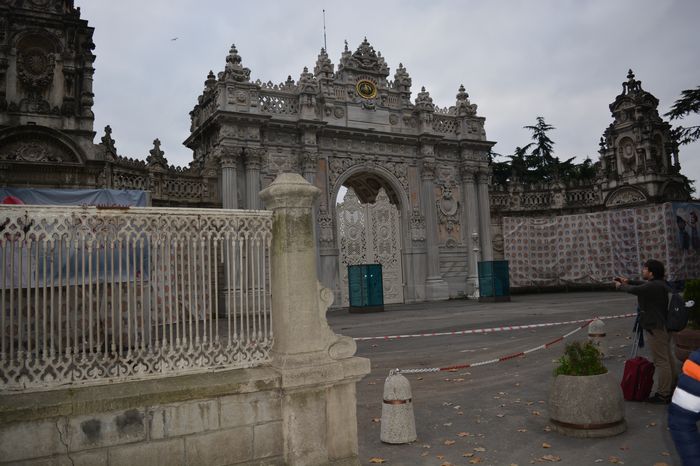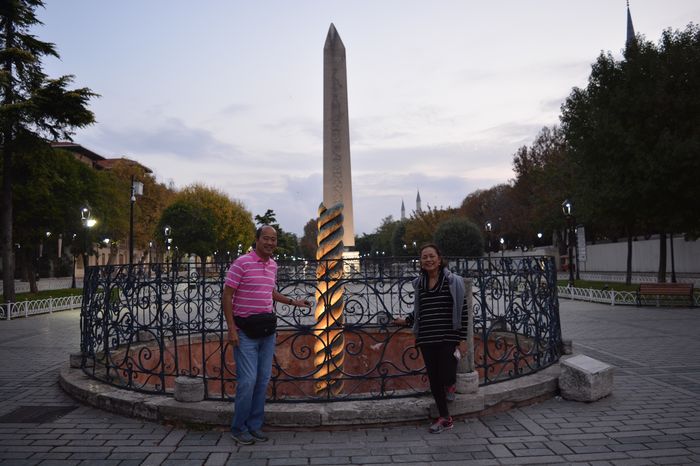When the dome collapsed, Paul tells us, clouds of dust darkened the day, the earth shook, but Christ protected his church and no one was killed: there was no defiling death in the holy place. In the poem, the city of Rome personified as a great woman appears to Justinian to exhort him, and he comforts her in return. The church reopened at the Christmas season to the eyes of the faithful.
Paul goes on to give us our best sixth-century description of the church: the supporting subdomes, then the dome of domes. With a connoisseur’s eye, he inventories the colors of all the marbles, the special green from Thessaly, the famous white from the great quarries at Proconnesus in the Sea of Marmara, and many others, from every direction under Justinian’s sway. Silver had been brought from all over as well to create four columns for the canopy over the altar. Above and over all, the great mosaic of Christ covered the dome, with Peter on one side and Paul on the other. At night, dazzling illumination flashed forth, with lamps hanging down on chains vast distances from the ceiling, poised at the right height to make the illusion of day. Within that space 60 priests, 100 deacons, 90 subdeacons, 110 readers, 25 singers, and a retinue of 100 doorkeepers brought the building and its services to life private bulgaria tours.
The great church must be imagined in the fullness of its life, with all the staff and clergy shepherding throngs of people into a space where they were doubly intimidated by architecture and ritual, then keeping them carefully in their places. The processions and hymns in the church occasionally erupted into the streets outside, as when late in the sixth century the emperor Maurice instituted an annual procession of thanks for a victory over the Persians that took a huge retinue through all the city out to the Virgin’s church at Blachernae.
Romanos the Melodist
The church was often not merely visually but also musically dazzling. Romanos the Melodist came from Syria in the days of Anastasius and flourished as poet of the imperial liturgy until his death sometime after 555. His dozens of surviving hymns speak in great detail to the celebrations of the annual liturgical calendar, turning a saint’s day or a church holiday into song with the urgent relevance of modern hip-hop, but with a serene and stately air. Thus Mary addresses the newborn Jesus in prayer:
Accept my child, a trinity of gifts, grant her who bore you three requests:
I pray to you for the seasons and for the fruits of the earth and for those who dwell in it.
Be reconciled to all
Because through me you have been born.
The pious astonishment of that space lasted 1,000 years, during which emperors of Constantinople would pose, pray, and be enthroned there. The people of the city waited on the emperor’s pleasure in the circus, while its god and its clergy greeted him in the church. Some scholars used to call Constantinople’s peculiar theocracy Caesaropapism, but the word overstates the fact. Patriarchs sometimes led emperors, emperors often dictated to patriarchs, and they were sometimes at loggerheads, but the sheer physical drama surrounding the divinely approved ruler every time he set foot in this space said more than any doctrinal definition could about the alignment of powers in the city and the empire. Nothing the Ottomans could do with the space quite made it live in the same way One Blue and one Green.
Between the two great spaces for public display, circus and church, was the emperor’s palace: the real heart of the city, the real showplace.
Rome never had room for the likes of this palace. It was far easier to build in the purpose-made imperial city than to try to squeeze such imperial pomp into the historic precincts of the ancient town that had outgrown itself long before. Constantinople and its palace were built from the ground up by people who understood what it was to have an empire to call your own. The palace was the centerpiece of that political statement, and therefore the seed of the eventual failure of the enterprise it embodied. It gave a forbidding appearance to the city and was the home of deep mysteries. It’s unlikely that any emperor who ever lived there saw all of its ramifications, dependencies, back rooms, and secret chambers.








